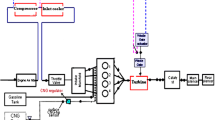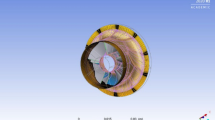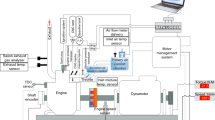Abstract
This work focuses on the numerical and experimental analysis of turbocharger selection and boost pressure effects on a CNG-fueled spark-ignition engine. Because of this, investigations are carried out on the influence of downsized compression ratio of 10.5:1 at different boost pressures and compared with a naturally aspirated compression ratio of 12.5:1. In order to perform the experimentation, a twin-cylinder, port fuel-injected, CNG engine with 15.5 kW at 3400 rpm is modified to utilize compressed bio-methane as fuel under 100% throttle condition. A simulation is performed to study the compressor impeller for T1 and T2 turbochargers using the ANSYS turbomachinery tool. Results indicate that the circumferential velocity of T1 is higher than of T2 at all boost pressures. Subsequently, experimentation is performed using T1 and T2 at three different boost pressure levels in a compression ratio of 10.5:1 at 1.1, 1.3, and 1.5 bar. T2 developed a maximum boost pressure of 1.1 bar compared to T1. T1 is chosen for further experimentations. At 1.3 bar of boost pressure, a rise in brake power was recorded by 19.3% compared to 12.5:1 under the naturally aspirated mode. Consequently, there is a reduction in fuel consumption by 10.1%, and hydrocarbon, carbon monoxide, and carbon dioxide emission levels reduce by 25%, 8.2%, and 4.9%, respectively. Therefore, turbocharging at a lower compression ratio exhibits better performance and reduces emissions compared to a higher compression ratio under naturally aspirated mode.
Graphic abstract







Similar content being viewed by others
Abbreviations
- A/F:
-
Air to fuel ratio
- BSFC:
-
Brake-specific fuel consumption
- CBM:
-
Compressed bio-methane
- CH4 :
-
Methane
- CNG:
-
Compressed natural gas
- CO:
-
Carbon monoxide
- CO2 :
-
Carbon dioxide
- COV:
-
Coefficient of variation
- CR:
-
Compression ratio
- Cu2 :
-
Circumferential velocity at impeller outlet
- EVC:
-
Exhaust valve closing
- EVO:
-
Exhaust valve opening
- HC:
-
Hydrocarbon
- HP:
-
Horse power
- ht:
-
Enthalpy at impeller inlet
- ht2 :
-
Enthalpy at impeller outlet
- IVC:
-
Intake valve closing
- IVO:
-
Intake valve opening
- LPG:
-
Liquefied petroleum gas
- MAPreq:
-
Manifold absolute pressure required
- N:
-
Engine speed
- NO:
-
Nitric oxide
- O2 :
-
Oxygen
- P1c:
-
Pressure at compressor inlet
- P2c:
-
Pressure at compressor outlet
- Pamb:
-
Ambient pressure
- r:
-
Centroid radius of the scroll
- r2:
-
Radii at impeller outlet
- Rg:
-
Exhaust gas constant
- T1:
-
KP31 turbocharger
- T1c:
-
Temperature at compressor inlet
- T2:
-
KP35 turbocharger
- T2c:
-
Temperature at compressor outlet
- TDC:
-
Top dead center
- T m :
-
Intake manifold temperature
- V d :
-
Displacement volume
- W a :
-
Actual airflow rate
- \(\eta_{{\text{C}}}\) :
-
Compressor efficiency
- \(\pi_{{\text{c}}}\) :
-
Pressure ratio
- ΔPloss:
-
Pressure loss
- ω:
-
Turbocharger speed
- C:
-
Compressor
References
Abbas Y, Jamil F, Rafiq S et al (2020) Valorization of solid waste biomass by inoculation for the enhanced yield of biogas. Clean Technol Environ Policy 22:513–522. https://doi.org/10.1007/s10098-019-01799-6
Amann CA (1985) Cylinder-pressure measurement and its use in engine research. SAE Trans. https://doi.org/10.4271/852067
Arroyo J, Moreno F, Muñoz M, Monné C (2013) Efficiency and emissions of a spark ignition engine fueled with synthetic gases obtained from catalytic decomposition of biogas. Int J Hydrog Energy 38:3784–3792. https://doi.org/10.1016/j.ijhydene.2013.01.087
Bordelanne O, Montero M, Bravin F et al (2011) Biomethane CNG hybrid: a reduction by more than 80% of the greenhouse gases emissions compared to gasoline. J Nat Gas Sci Eng 3:617–624. https://doi.org/10.1016/j.jngse.2011.07.007
Burke RD, Vagg CRM, Chalet D, Chesse P (2015) Heat transfer in turbocharger turbines under steady, pulsating and transient conditions. Int J Heat Fluid Flow 52:185–197. https://doi.org/10.1016/j.ijheatfluidflow.2015.01.004
Cardona CA, Amell AA (2013) Laminar burning velocity and interchangeability analysis of biogas/C 3H8/H2 with normal and oxygen-enriched air. Int J Hydrog Energy 38:7994–8001. https://doi.org/10.1016/j.ijhydene.2013.04.094
Chandra R, Vijay VK, Subbarao PMV, Khura TK (2011) Performance evaluation of a constant speed IC engine on CNG, methane enriched biogas and biogas. Appl Energy 88:3969–3977. https://doi.org/10.1016/j.apenergy.2011.04.032
D’Ambrosio S, Spessa E, Vassallo A et al (2006) Experimental investigation of fuel consumption, exhaust emissions and heat release of a small-displacement turbocharged CNG engine. SAE Tech Pap. https://doi.org/10.4271/2006-01-0049
Einewall PJB (1997) Combustion chambers for supercharged natural gas engines. SAE Trans. https://doi.org/10.4271/970221
Garrett (2019) Turbo Tech 103|Expert: compressor mapping, pp 1–13
Gumus M (2011) Effects of volumetric efficiency on the performance and emissions characteristics of a dual fueled (gasoline and LPG) spark ignition engine. Fuel Process Technol 92:1862–1867. https://doi.org/10.1016/j.fuproc.2011.05.001
Heesterman ARG (2019) Renewable energy supply and carbon capture: capturing all the carbon dioxide at zero cost. Clean Technol Environ Policy 21:1177–1191. https://doi.org/10.1007/s10098-019-01716-x
Heywood JB (2011) Internal combustion engine fundamentals. McGraw Hill Education (India) Private Limited, New Delhi
Heywood JB, Welling OZ (2009) Trends in performance characteristics of modern automobile SI and diesel engines. SAE Tech Pap 2:1650–1662. https://doi.org/10.4271/2009-01-1892
Hinton N, Stone R (2014) Laminar burning velocity measurements of methane and carbon dioxide mixtures (biogas) over wide ranging temperatures and pressures. Fuel 116:743–750. https://doi.org/10.1016/j.fuel.2013.08.069
Huppmann D, Kriegler E, Krey V et al (2019) IAMC 1.5°C scenario explorer and data hosted by IIASA. In: Integrated assessment modeling consortium & international institute for applied systems analysis
Iyer H, Shaik R, Vagesh A et al (2011) Turbocharging a small two cylinder di diesel engine—experiences in improving the power, low end torque and specific fuel consumption. SAE Tech Pap. https://doi.org/10.4271/2011-24-0133
Jung C, Park J, Song S (2015) Performance and NOx emissions of a biogas-fueled turbocharged internal combustion engine. Energy 86:186–195. https://doi.org/10.1016/j.energy.2015.03.122
Kellermayr G, Schutting E, Mitterecker H (2019) Turbocharging of engines with low cylinder numbers: a thermodynamic consideration. Automot Engine Technol 4:153–167. https://doi.org/10.1007/s41104-019-00048-8
Koonaphapdeelert S, Aggarangsi P, Moran J (2019) Biomethane: production and applications. Springer, Singapore
Lau CS, Allen D, Tsolakis A et al (2012) Biogas upgrade to syngas through thermochemical recovery using exhaust gas reforming. Biomass Bioenergy 40:86–95. https://doi.org/10.1016/j.biombioe.2012.02.004
Leiker M (1972) Evaluation of antiknocking property of gaseous fuels by means of methane number and its practical application to gas engines. Mech Eng 94:55
Mataczynski MR, Litke P, Naguy B, Baranski J (2016) Characterization of small-scale turbochargers for unmanned aerial systems. SAE Tech Pap. https://doi.org/10.4271/2016-32-0078
Mathur ML, Sharma RP (2014) Internal combustion enigne. Dhanpat Rai Publications (P) Ltd, New Delhi
Moffat RJ (1988) Describing the uncertainties in experimental results. Exp Therm Fluid Sci 1:3–17. https://doi.org/10.1016/0894-1777(88)90043-X
Mohan A, Jaliwala J, Bhagat K, Patchappalam K (2019) A comprehensive study on euro 6 turbocharger selections and its deterioration with closed crank-case ventilation in heavy commercial vehicles. SAE Tech Pap. https://doi.org/10.4271/2019-24-0061
Molino A, Migliori M, Ding Y et al (2013) Biogas upgrading via membrane process: modelling of pilot plant scale and the end uses for the grid injection. Fuel 107:585–592. https://doi.org/10.1016/j.fuel.2012.10.058
Muhumuza R, Zacharopoulos A, Mondol JD et al (2018) Energy consumption levels and technical approaches for supporting development of alternative energy technologies for rural sectors of developing countries. Renew Sustain Energy Rev 97:90–102. https://doi.org/10.1016/j.rser.2018.08.021
Nguyen-Schäfer H (2012) Thermodynamics of turbochargers. In: Rotordynamics of automotive turbochargers. Springer, Berlin, pp 17–31
Niemi SA, Laurén MJ (2002) Effect of waste-gate turbocharging on the exhaust particulate matter of an off-road diesel engine. SAE Tech Pap. https://doi.org/10.4271/2002-01-2159
Padmavathi R, Nandhakumar K DP (2010) Effect of turbocharger geometrical configurations on engine performance and emissions. In: Proceedings of 10th international symposium, Stuttgart. Stuttgart, Germany
Porpatham E, Ramesh A, Nagalingam B (2008) Investigation on the effect of concentration of methane in biogas when used as a fuel for a spark ignition engine. Fuel 87:1651–1659. https://doi.org/10.1016/j.fuel.2007.08.014
Porpatham E, Ramesh A, Nagalingam B (2013) Effect of swirl on the performance and combustion of a biogas fuelled spark ignition engine. Energy Convers Manag 76:463–471. https://doi.org/10.1016/j.enconman.2013.07.071
Qi DH, Lee CF, Safety A (2016) Combustion and emissions behaviour for ethanol–gasoline-blended fuels in a multipoint electronic fuel injection engine. Int J Sustain Energy. https://doi.org/10.1080/14786451.2014.895004
Raju SR (2001) Experimental investigation on the performance of a lean burn spark ignition gas engine [Ph. D Thesis]. IIT Madras, Chennai, India
Rautenberg M, Malobabic M MA (1984) Influence of heat transfer between turbine and compressor on the performance of small turbochargers. In: 1983 Tokyo international gas turbine congress, pp 567–574
Ray P (2019) Renewable energy and sustainability. Clean Technol Environ Policy 21:1517–1533. https://doi.org/10.1007/s10098-019-01739-4
Shaaban SSJ (2006) Analysis of turbocharger non-adiabatic performance. In: 8th International conference on turbochargers and turbocharging, pp 119–130
Shivapuji AM, Dasappa S (2014) Selection and thermodynamic analysis of a turbocharger for a producer gas-fuelled multi-cylinder engine. Proc Inst Mech Eng Part A J Power Energy 228:340–356. https://doi.org/10.1177/0957650913517677
Singh M, Sandhu SS (2021) Effect of boost pressure on combustion, performance and emission characteristics of a multicylinder CRDI engine fueled with argemone biodiesel / diesel blends. Fuel 300:121001. https://doi.org/10.1016/j.fuel.2021.121001
Sun Z, Zheng X, Linghu Z et al (2019) Influence of volute design on flow field distortion and flow stability of turbocharger centrifugal compressors. Proc Inst Mech Eng Part D J Automob Eng 233:484–494. https://doi.org/10.1177/0954407017746281
Tanin KV, Wickman DD, Montgomery DT et al (1999) The influence of boost pressure on emissions and fuel consumption of a heavy-duty single-cylinder D.I. diesel engine. SAE Tech Pap. https://doi.org/10.4271/1999-01-0840
Thurnheer T, Soltic P, Dimopoulos Eggenschwiler P (2009) S.I. engine fuelled with gasoline, methane and methane/hydrogen blends: Heat release and loss analysis. Int J Hydrog Energy 34:2494–2503. https://doi.org/10.1016/j.ijhydene.2008.12.048
Tippayawong N, Thanompongchart P (2010) Biogas quality upgrade by simultaneous removal of CO2 and H2S in a packed column reactor. Energy 35:4531–4535. https://doi.org/10.1016/j.energy.2010.04.014
Turns SR (1996) Introduction to combustion. The McGraw-Hill Companies, New York
Vu TKV, Vu DQ, Jensen LS et al (2015) Life cycle assessment of biogas production in small-scale household digesters in Vietnam. Asian-Austr J Anim Sci 28:716–729. https://doi.org/10.5713/ajas.14.0683
Watson N (1988) Turbocharged Engines. Academic Press Limited, Cambridge
Weaver CS (1989) Natural gas vehicles—a review of the state of the art. SAE Tech Pap. https://doi.org/10.4271/892133
Wong JK (1977) Study of mixtures of methane and carbon dioxide as fuels in a single cylinder engine (CLR). SAE Tech Pap. https://doi.org/10.4271/770796
Zhao B, Zhao Q, Zhao W et al (2020) Numerical and experimental investigation of turbocharger compressor low-end performance improvement using a variable geometry inlet orifice. Int J Engine Res. https://doi.org/10.1177/1468087420951097
Acknowledgements
The authors gratefully thank the Science and Engineering Research Board (SERB), India, Project No: EMR/2016/004138, for the valuable funding, and the Vellore Institute of Technology (VIT), for their immense support to conduct the research work.
Author information
Authors and Affiliations
Contributions
EP was involved in supervision, conceptualization, methodology, writing—review and editing. JA helped in data generation, formal analysis, writing—original draft, writing—review and editing.
Corresponding author
Ethics declarations
Conflict of interest
The authors declare that they have no conflict of interest.
Additional information
Publisher's Note
Springer Nature remains neutral with regard to jurisdictional claims in published maps and institutional affiliations.
Electronic supplementary material
Below is the link to the electronic supplementary material.
Appendix
Appendix
The experimentation was conducted by varying the compression ratio at 10.5:1 and 12.5:1 for naturally aspirated and turbocharged modes, respectively. The compression ratio was varied by changing the thickness of the gasket, increasing the thickness gives a lower compression ratio, and decreasing the gasket thickness gives a higher compression ratio. The following equation gives the calculation used for estimating the compression ratio.
Rights and permissions
About this article
Cite this article
Alexander, J., Porpatham, E. Numerical and experimental analysis on the effects of turbocharged compressed bio-methane-fueled automotive spark-ignition engine. Clean Techn Environ Policy 25, 465–482 (2023). https://doi.org/10.1007/s10098-021-02161-5
Received:
Accepted:
Published:
Issue Date:
DOI: https://doi.org/10.1007/s10098-021-02161-5




